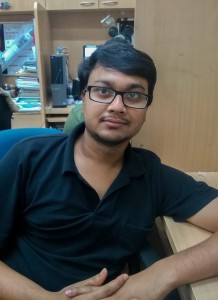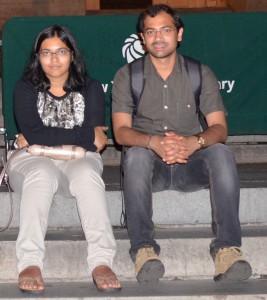Three young scientists were recognized for their contributions at the 6th International Conference on Metals and Genetics, which took place earlier this year at the Indian Institute of Science in Bangalore.
The winners (in no particular order) of the NJC Poster Prizes awarded at this conference were:
Mr Vadde Ramu, National Chemical Laboratory, Pune
Poster title: New imaging reagents for lipid dense regions in live cells and the nucleus in fixed MCF-7 cells
The presented work is part of Vadde’s Ph.D. thesis, carried out under the supervision of Dr. Amitava Das. Vadde will be defending his thesis work this month and is moving to Jena for a post-doctoral position in October.
The presented research work demonstrated the design and synthesis of two new uracil (U) and 5-flurouracil (5-FU) labelled ruthenium(II)-polypyridyl based cellular imaging reagents. These two complexes were found to show affinity towards DNA in the nucleus of the PFA fixed cells. A large Stokes shift (λ = 160 nm) and an appreciably long-lived 3MLCT excited state (λ = 320 ns) in aq. buffer medium (pH 7.4) are other key features of these complexes. Unlike the common nuclear DNA staining reagents like DAPI, these low-cytotoxic reagents are found to be highly stable towards photo-bleaching upon irradiation with λ > 455 nm at the MLCT band for these complexes. |
 |
Mr Samsuzzoha Mondal, Tata Institute of Fundamental Research, Mumbai
Poster title: Sensing Signalling Phospholipids with ‘Lanthano-proteins’
Samsuzzoha is a Ph.D. student working in the group of Dr. Ankona Datta. He is in his final year and expects to defend his degree in mid-2017.
His present research is about developing fluorescent probes for imaging the crucial phospholipids involved in cell signaling processes. Currently available genetically encoded fluorescent probes lack ‘on-off’ sensing and have problems with background signal. Hence tracking the spatio-temporal dynamics of phospholipids in a live cellular process with those fluorescent proteins is challenging. The authors are addressing this issue by developing novel fluorescent probes with ‘turn on’ or ‘ratiometric’ fluorescence sensing. The poster presents a ‘lanthano’-protein based ‘turn on’ sensor for phosphatidylserine, a phospholipid involved in cell-death signals mediation and several other signaling processes. Additionally, a recently developed, cell permeable, ratiometric sensor for phosphoinositides, the most important signaling phospholipids in the cellular system, is demonstrated. |

|
Ms Tandrila Das, Indian Institute of Science, Bangalore
Poster title: Vacancy-Engineered Nanoceria: Enzyme Mimetic Hotspots for the degradation of Nerve Agents
Tandrila did the work presented in the poster as a 5th year BS-MS student under the direction of Prof. Govindasamy Mugesh. She is now a 1st year student in the Tri-Institutional Ph.D. program in chemical biology offered by Weill Cornell Medicine, Memorial Sloan-Kettering Cancer Center and The Rockefeller University (all located in New York City).
The study of phosphotriesterase (PTE) enzymes and synthesis of its structural and functional mimics has been a long time interest of the lab. PTE enzymes degrade organophosphorus nerve agents, which are known to inhibit acetylcholine esterase, thus resulting in paralysis, respiratory failure, etc. For her Master’s thesis, Tandrila worked on developing a nano-mimic of PTE enzyme. The poster work showed that vacancy engineered nanoceria (CeO2) with Ce in both +3 and +4 oxidation states very efficiently act as a catalyst to hydrolyze organophosphorus nerve agents like paraoxon, parathion, etc.
(The photo shows Tandrila on the left with co-author Dr Amit Vernekar, currently a post-doc in the Lippard group at MIT.) |
 |
Congratulations to the 3 laureates, and best wishes for continuing success in their research and careers.













